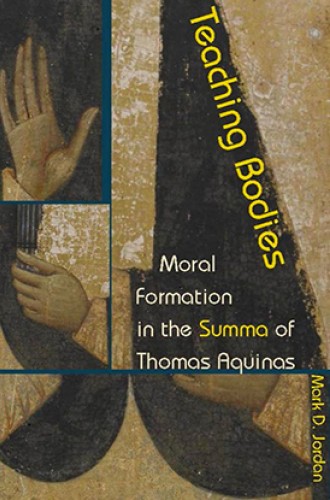In some classics of Christian theology, sheer bulk comes to function as a pedagogical strategy. You set out on City of God or Church Dogmatics hoping to sack them like a city; you return from them a humble mendicant. Day after day, year after year, they frustrate your plans and mortify your pride—you thought you’d be done by now, and instead you’re still toiling your way through the prolegomena, of which you understood maybe a third.
Such books give rise to a parallel tradition: books that offer a traveler’s guide to these classic works alongside a theological vision or argument of their own. (Think of John Webster on Barth or Anne M. Carpenter on Balthasar.) Mark Jordan’s luminously readable and intelligent book belongs to this tradition. I will carry it with me the next time I try (and fail) to learn my way around that ancient city Summa Theologica.
Jordan believes, with Thomas Aquinas, that the human person is “an intellect that learns through the body” and that we “learn best how to live from enacted examples”:
We learn the best way to teach human beings by watching how God taught us. God did not send down a numbered list of moral axioms or a crisply formulated universal imperative. God took flesh. Embodied souls learn through bodies and from bodies. They learn from particular scenes enacted in time. Given the effects of sin in human hearts and human history, these scenes must be both urgent and memorable. . . . Only when a reader appreciates such a pedagogy can she rightly assemble the elements of the moral account that make up the middle of the Summa.
Modern readers have trouble appreciating such a pedagogy. We read experience backward, extracting generals from particulars like someone shelling a nut. We must learn to think differently about our own embodiment if we want to hear anything Aquinas is saying. Jordan suggests, then, that modern readers of the Summa “begin with the end”—Summa 3—because it offers a treatment of incarnation, sacrament, and resurrection. He explains: “Read whole, Summa 3 is a long praise of the pedagogical appropriateness of God’s becoming human.”
“Appropriateness” is an important part of Jordan’s argument. He performs a fascinating excavation of Aquinas’s concept of the incarnation’s convenientia, its fittingness. God could have redeemed us some other way, perhaps, but incarnation is the most appropriate, most fitting way because, given God’s and our natures, it gives the most bang for the buck. It teaches by example, shows us our “participation in divinity” and the dignity of our nature, kills our pride, and does any number of other jobs at once. This style of argument drives Aquinas’s treatment of the incarnation and becomes “the great principle animating the third part of the Summa,” where Aquinas finds a similar fittingness in the sacraments.
Bodies, of course, exist in space. If God must take our embodiment into account when teaching us through the incarnation and the sacraments, spaces and contexts matter. Accordingly, Jordan turns our attention to the way classical and medieval moral instruction is often written: as a scene that takes place somewhere, in time, with characters. Socrates is always arriving at a festival or showing up for a party or meeting a friend at the gym.
Jordan argues that this tradition is still important for Aquinas, who wants us to read the Bible (and in particular the scenes of Christ’s life) in this way: “The various characters in a scene of instruction are not bright drapery for moral lessons taught more accurately in the form of rules or theories. If they exemplify certain actions concretely, they teach action only through certain affective relations they enable for a learner.” If this is Aquinas’s intention (rather than Jordan’s intention for him!), we have to ask why Aquinas wrote his Summa as a series of disputed questions. Jordan has a plausible answer:
Thomas does not write the Summa as a narrative because the teacher’s virtues he means to show are those of inheriting a narrative more persuasive than any he could write. . . . Thomas does not want his stories, his fables, to compete with those being written by the Trinity onto hearts.
The “scene of instruction” still exists for Aquinas. It is the “divine pedagogy that continues to unfold in recounted revelation, sacrament, and vowed community.”
This pedagogy ultimately directs us, here in the middle of salvation history, from the sacraments and Summa 3 back to the “present life depicted in the second part”—Summa 2—where Aquinas discusses the virtues. Jordan concludes with a quick look at some important moments in Summa 2, “moments at which the reader is moved simultaneously toward God as end and toward God’s incarnate teaching as it will appear in Summa 3.” But Jordan’s book is mainly about Summa 3, a glimpse of the structure of the whole city as beheld from its highest point.
Aquinas never finished Summa 3, of course. He had his famous vision, or so the hagiographers tell us, and stopped writing: “All I have written seems as straw to me.” In its abandonment as in its arguments, the Summa points beyond itself to God. Jordan points us to both.







